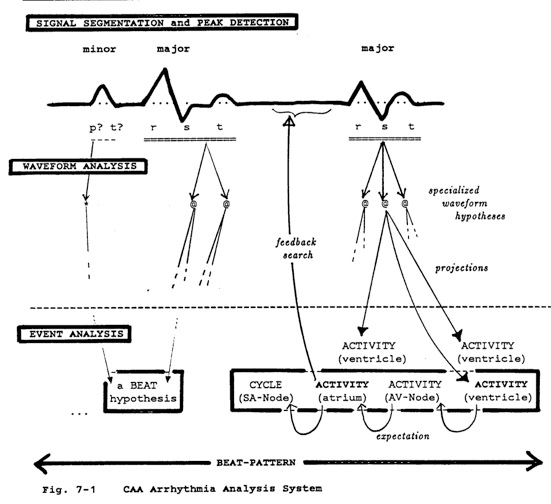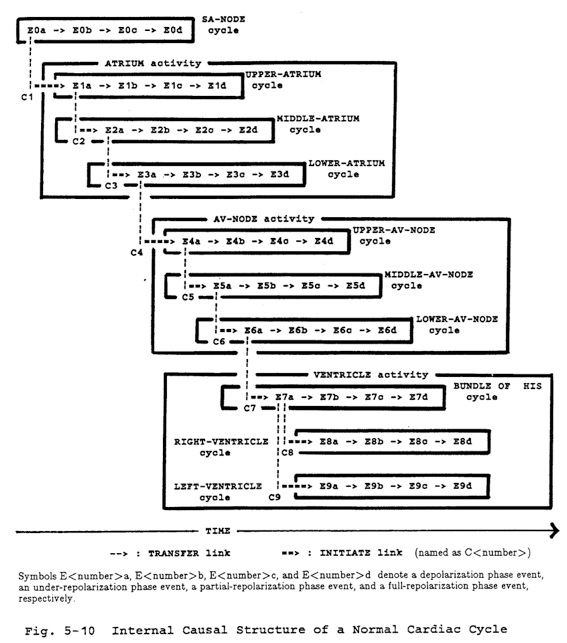CAA: Using Causal Knowledge for Arrhythmia Detection
The knowledge-based systems approach has been pursued to establish a framework for the recognition of time-varying vital signals of a complex repetitive nature, such as electrocardiograms (ECGs).
Using a stratified knowledge base, the proposed recognition system discerns several perspectives about the phenomena of underlying entities, such as the knowledge of a causal model of the physiological mechanism and the observational knowledge of the temporality and the morphology of signals emitted from physiological events, where such events are projected into the observable waveform domain. The system reasons observational abnormalities in the signal by referring to the corresponding abnormalities of causal connections and events in the entity model. Projection links have been defined to represent projection in our frame-type formalism and are used to raise hypotheses across different component KBs.
Our system also introduces and uses causal links extensively to represent various causal and temporal relations between concepts in the physiological event domain. The control structure uses causal links to expect unseen events from recognized events, to search for the corresponding waves in input data, and to match and calculate the degree of integrity among causally related events. The meta-knowledge representation of statistical information about events facilitates a default reasoning mechanism and supports this expectation process, providing context-sensitive statistical information.
Our design technology has been applied to the unsolved arrhythmia problem in the ECG domain and this prototype is called the CAA (Causal Arrhythmia Analysis) system. Our system inherits its basic control mechanisms from the ALVEN (A Left VENtricular Wall Motion Analysis) system, such as the change/focus attention mechanism with similarity links.
The CAA system with a limited number of abnormalities has been implemented using the PSN (Procedural Semantic Network) knowledge representation system. The prototype demonstrated promising results using independently sampled ECG data.



References
-
•Tsotsos, J.K., Shibahara, T., "Knowledge Organization and its Role in Temporal and Causal Signal Understanding: The ALVEN and CAA Projects", in Expert System Applications, ed. by L. Bolc and M. Coombs, Springer-Verlag, pp. 429 - 468, 1988.
-
•Tsotsos, J.K., Shibahara, T., "The Role of Knowledge Organization for Temporal and Causal Reasoning: The ALVEN and CAA Projects", in The Knowledge Frontier: Essays in the Representation of Knowledge, pp. 221 - 261, ed. by N. Cercone and G. McCalla, Springer-Verlag, 1987.
-
•Shibahara, T., ON USING CAUSAL KNOWLEDGE TO RECOGNIZE VITAL SIGNALS: A STUDY OF KNOWLEDGE-BASED INTERPRETATION OF ARRYTHMIAS, Ph.D. Thesis, Dept. of Computer Science, University of Toronto, August 1985.
-
•Mylopoulos, J., Shibahara, T., Tsotsos, J., "Towards a Technology for Building Knowledge Based Systems: The PSN Experience", IEEE Computer, Vol. 16, No. 10, October, 1983, p83 - 89.
-
•Shibahara, T., Tsotsos, J., Mylopoulos, J., Covvey, H.D., "CAA: A Knowledge Based System using Causal Knowledge to Diagnose Cardiac Rhythm Disorders", Proc. International Joint Conference on Artificial Intelligence, Karlsruhe, Germany, Aug. 1983, p231 - 237